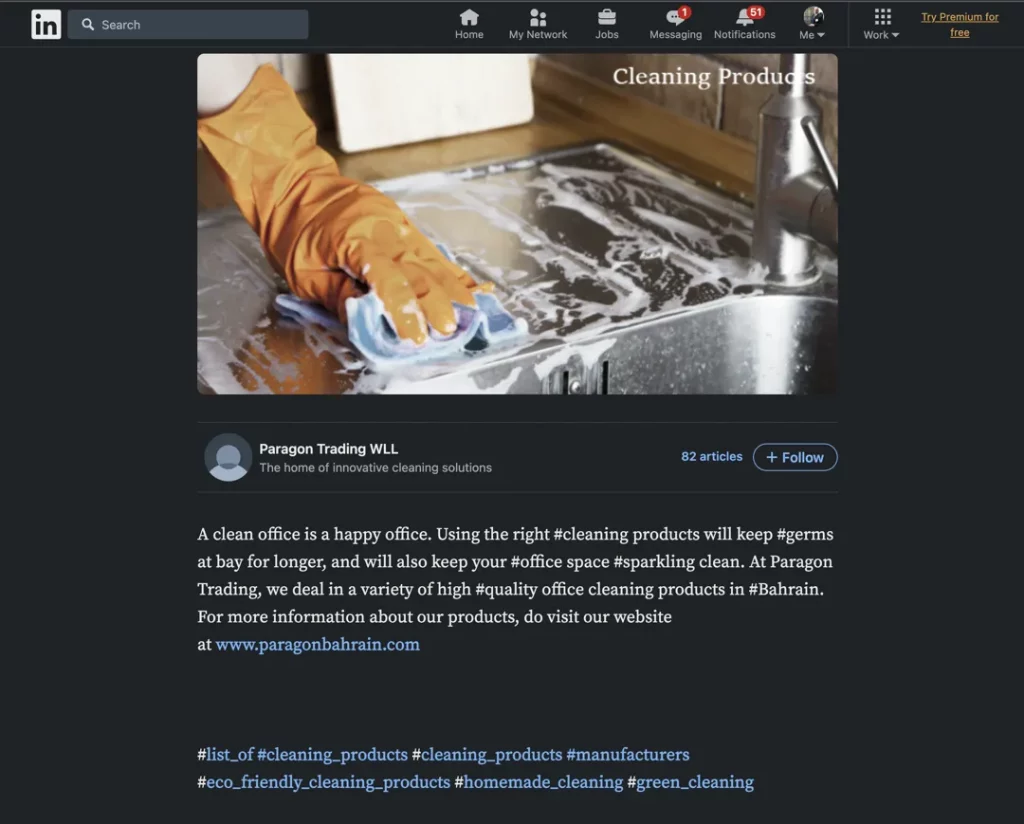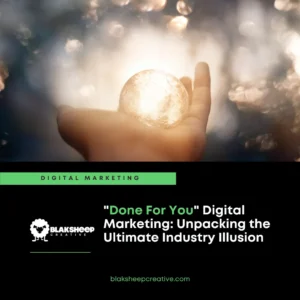When it comes to the effective marketing of small businesses online, you may be tempted to put all of your efforts into the big three: Facebook advertising, Google Adwords, and email marketing. But if you’re not utilizing Linkedin to its full potential, you could miss out on a valuable opportunity to connect with potential customers and clients.
To help small businesses make the most of their Linkedin marketing efforts, we’ve compiled a list of 13 strategies that small business owners can use to market their business on Linkedin effectively.
By the time you’ve finished reading this post, you’ll better understand how to market your small business on Linkedin and see results. Let’s get started!
But first, let’s lay a solid foundation for the Linkedin platform and why any business owner can benefit from it.
Or better said, why do small business owners need to include Linkedin in their marketing strategy?

What is Linkedin?
Linkedin is a business-oriented social networking platform that allows users to connect with other professionals in their field. It’s often thought of as a way to build relationships and create opportunities for career advancement, but it can also be used as an effective marketing tool.
Linkedin can be an excellent way for small businesses to connect with potential customers, build relationships, and create brand awareness. In addition, Linkedin offers several features and tools that you can use to market your business effectively.
Now that we’ve answered the question, “what is Linkedin?” let’s look at why you should Include Linkedin in your social media and content marketing strategy.
Why Linkedin should be an essential part of your social media and content marketing strategy:

Linkedin has 810 million members.
Although not the largest of the social networks (Instagram has over 1.2 billion, and Facebook almost 3 billion), the power here lies in the audience. Linkedin is made up of business professionals from around the world, making it the perfect platform to market your business.
Linkedin is an excellent platform for content marketing.
Content marketing on Linkedin allows you to share blog posts, infographics, eBooks, and other types of content that can help position you as an expert in your industry. In addition, Linkedin offers many features that make sharing and distributing content easy, such as the ability to embed content from your website or blog directly into your Linkedin profile.
Linkedin Pages are great for lead generation.
If you’re looking for a platform that can help you generate leads for your business, Linkedin is a great option. Linkedin allows you to use targeted ads to reach a specific audience, and several lead generation tools can be used to capture leads directly from Linkedin.
Linkedin is perfect for B2B Marketing.
If your business is focused on marketing to other businesses (B2B), then Linkedin should definitely be a part of your social media strategy. Linkedin is filled with business partners and decision-makers who are always looking for new products and services to help them run their businesses more effectively.
If you’re not using Linkedin to connect with other professionals in your field, you’re missing out on a valuable opportunity to network and build relationships. Connecting with others on Linkedin can create opportunities for collaboration, referral business, and joint ventures.
Now that we’ve looked at why Linkedin should be included in your social media and content marketing strategies, let’s take a look at thirteen specific techniques you can use to market your small business on Linkedin.
Thirteen Strategies For Marketing Your Small Business On Linkedin
Here’s what you came here for strategies that can be used to market a business on Linkedin effectively. So let’s dig in!

1. Creating a Company Linkedin Page
Don’t rely on your personal Linkedin profile to promote your business; a company page is essential to marketing your business on Linkedin.
If you don’t already have one, the first step is to create a Linkedin Company Page for your business. Linkedin pages allow you to share information about your company, post updates and articles, and showcase your products or services.
You’ll need a Linkedin account with a personal profile to create a company page. If you don’t have one, sign up for Linkedin and create a personal profile. Once logged in, go to “Create a Company Page,” and follow the instructions.
Be sure to add a background photo.
Adding a background photo to your Linkedin Company Page is a great way to make a good first impression. Be sure to choose an image that’s high quality and represents your brand well.
Take advantage of the blog and website links on your Linkedin profile.
If you want to increase your website’s visitors, take advantage of the blog and website links on your Linkedin profile. Adding these links to your profile makes it easy for others to find your website and blog and see other valuable content you’re producing.
Plus, the links are powerful backlinks for your website, which can help increase your domain’s authority and improve your search engine rankings.
Search engines love backlinks!
To learn how to create a company Linkedin Page, check out this article at Linkedin’s business help.
2. Optimizing Your Company Page
Once you’ve created your Company Page, it’s important to take some time to optimize it for search engine optimization (SEO). This will help ensure that your Page shows up in search results when people search for businesses like yours.
If you optimize your company page, search engines will be more likely to find it and rank it high in the search results. This means more people will see your Page and be able to learn about your business.
There are a few key things you can do to optimize your Company Page:
Choose the right category for your business.
This will help Linkedin determine which searches your Page should show up for. After all, you want your Page to only show up for searches relevant to your business.
Add keywords to your company description.
Linkedin allows you to add up to 200 characters to your company description. Use this space wisely by incorporating keywords that describe your business and what you do. But beware of keyword stuffing when you stuff too many keywords into your description to game the system.
Not only will this not help your Page rank higher, but it will also make your description challenging to read.
Include a call-to-action (CTA) on your Page.
A CTA is a statement or question that encourages people to take a specific action. For example, your CTA could be “Sign up for our newsletter” or “Download our e-book.”
Your CTA should be linked to a landing page on your website where people can take the desired action. This helps you track how many people are taking action from seeing your CTA on Linkedin.
Adding a CTA to your Company Page can increase leads and conversions from Linkedin.
To learn more about creating custom CTAs on your Linkedin Page, here’s an informative article over at Linkedin.
Now that you’ve got your company page completed, let’s discuss how to post relevant, engaging content.
3. Posting Relevant, Engaging Content
Once you’ve created and optimized your Company Page, it’s time to start posting relevant and engaging content. This could include writing blog posts, sharing articles, and creating videos, infographics, or anything else that interests your target audience.
But what does relevant, engaging content mean?
Relevant: The content you post should be relevant to your target audience. For example, if you’re a B2B (business to business) company that provides software to small businesses, relevant content would be about topics like small business growth, using technology to improve efficiency, or case studies of companies that have used your software.
Engaging: The content you post should also be engaging. This means it should be interesting and informative enough to get people to stop scrolling through their newsfeeds and take notice.
Some ways to make your content more engaging include:
- Asking questions
- Using images or videos
- Starting a conversation
- Using emojis
- Telling a story
- Offering a resource
Take note of what Vanta did in their LinkedIn post. They offered a GPDR compliance checklist to help their followers:
When posting content on your Linkedin Company Page, it’s important to:
Post regularly.
If you only post once in a while, people will forget about your Page. Try to post at least once a week, but daily is even better. The important thing to remember is that your Linkedin audience doesn’t want to be sold to all the time.
Post with purpose.
Unlike your personal Linkedin profile, your posts should be written for a professional audience, as this is a platform for business networking.
That being said, just like a blog post, social media post, or other pieces of content, every post should have a purpose.
Post with a goal.
Before you hit publish on a post, ask yourself: What is the goal of this post? Do you want people to:
- Learn something new?
- Be entertained?
- Take action (click through to your website, sign up for your newsletter, etc.
- Generate leads?
The answer to these questions will help you determine what type of content to post. For example, if your goal is lead generation, you could include a CTA that leads people to a landing page where they can sign up for your newsletter or download an e-book or some other type of magnet for generating leads.
Mix up your content.
Don’t just post written articles all the time. Mix things up with videos, infographics, and other types of content to keep people engaged.
Again, don’t post content just for the sake of posting it. Everything you post should provide value to your audience and be relevant to your business.
Learn from other businesses.
If you need help determining what kind of content to post, look at what other businesses in your industry are posting. Check out their Linkedin pages and see what resonates with their audience.
You can also use Linkedin’s Pulse app to find and curate content from around the web to share with your audience.
Or keep in mind what’s trending when creating content for your Linkedin Company Page.
Now, let’s dive deeper into the importance of engaging with your audience.
4. Engaging With Your Audience
Social media platforms are meant to be social. This means you should be engaging with your audience regularly.
Engagement could include:
- Replying to comments on your posts
- Asking questions
- Posting polls
- Sharing user-generated content
- Announcing company news, milestones, or events
When you engage with your audience, you’re building relationships, which can lead to more sales down the line.
Remember, one of the main goals of marketing on Linkedin is to foster business relationships.
Engaging with your audience makes you more likely to build trust and credibility, which are essential for any business relationship.
Plus, the Linkedin algorithm favors content with high engagement, so the more you interact with your audience, the more people will see the more likely your posts.
5. Use Hashtags
Hashtags are a great way to get your content seen by more people, especially if you’re using relevant and popular hashtags.
When choosing hashtags, consider the following:
- The relevance of the hashtag to your business
- How popular the hashtag is
- How specific the hashtag is
For example, let’s say you sell eco-friendly cleaning products. A relevant, popular, and specific hashtag you could use is #ecofriendlycleaningproducts.

A less specific but still relevant and popular hashtag would be something like #sustainability.
You can also create custom hashtags for your business. For example, many businesses use branded hashtags for their company or product names.
6. Create and Share Compelling Content
As we mentioned before, the content you post on your Linkedin Company Page should provide value to your audience and be relevant to your business.

Your content could include the following:
- Blog posts
- Videos
- Infographics
- Images
- Announcements
- Industry news
To make sure your content is compelling, consider using some of these content creation tips:
- Write compelling headlines that make people want to click
- Write in a clear and concise manner.
- Use short paragraphs.
- Use bullet points.
- Leverage data and statistics.
- Use images, videos, and infographics.
Remember, to effectively market your business on Linkedin, you need to create content that will resonate with your audience and provide value.
7. Use Linkedin Ads
Linkedin Ads are a great way to get your content seen by more people, specifically your target audience.
When creating a Linkedin ad, consider the following:
- Your business goals
- Your target audience
- The type of content you’re promoting
- Your budget
Linkedin Ads is a powerful marketing tool that can help you reach your target audience and achieve your business goals.
8. Host a Linkedin Event
Linkedin events are a simple method to create and join professional gatherings such as meetups, online workshops, seminars, and more. Linkedin members can discover and join communities that will help them develop their businesses, network with people, and learn new skills.
To learn more about hosting a Linkedin event, check out this helpful guide.
9. Seek Out and Join Relevant Groups
Groups are a great way to connect with like-minded professionals and learn from experts in your industry. Here’s a secret: Groups are probably, the most overlooked Linkedin marketing strategy.
When looking for groups to join, consider the following:
- The size of the group
- The activity level of the group
- The relevance of the group to your business
- The type of discussions taking place in the group
To find relevant groups, search for keywords related to your industry or business in Linkedin’s search bar.
10. Create your Own Linkedin Group
Can’t find Linkedin groups that are relevant to your audience? Why not create your own?
No Linkedin groups that match your personal brand? Why not create your own?
Creating a Linkedin group is a great way to build an engaged community around your business. Plus, it may just generate a few sales leads!
Plus, as the group’s creator and administrator, you have control over who joins the group and what type of content is shared.
Invite your existing Linkedin connections, relevant audience, network of contacts, colleagues, and customers to join your group and start discussions about relevant topics.
Encourage group members to share your group with their network of connections.
Creating a Linkedin group is a great way to build an engaged community and market your business on Linkedin.
In short, Linkedin groups are one of the best ways to connect with like-minded professionals, learn from industry experts, and generate business leads.
11. Get Active in Discussions
Discussions are a great way to get your name and business out there. When you’re active in discussions, you’re building relationships, which can lead to more sales down the line.
Remember, one of the main goals of marketing on Linkedin is to foster business relationships. So, when you’re active in discussions, you’re not only marketing your business, but you’re also building relationships with potential customers and partners.
When participating in discussions, consider the following:
- The relevancy of the discussion to your business
- The type of audience that is participating in the discussion
- How you can add value to the discussion
Discussions are a great way to get your name and business out there. When you’re active in discussions, you’re building relationships, which can lead to more sales down the line.
To find posts to engage with, you can:
- Check your notifications tab on Linkedin. Any time someone likes, comments, or shares one of your posts, you’ll get a notification. Responding to these notifications is a great way to jump into discussions.
- Check Linkedin groups. Groups are a great place to find relevant discussions. Simply search for keywords related to your industry or business in Linkedin’s search bar.
- Comment on your friends’ posts. This one is tricky, as you only want to comment on posts that are relevant to your business. But if you have something valuable to say, commenting on a friend’s post is a great way to get involved in discussions.
Just like Facebook groups, whether you are trying to raise brand awareness, reach new audiences, or generate leads, getting involved in discussions is a great way to achieve your goals.
11. Create a Linkedin Showcase Page
If you want to highlight certain brands, business units, or initiatives on Linkedin, Showcase Pages are perfect for you. Once created, they’ll be listed under ‘Affiliated Pages’ on your main Linkedin Page.
Showcase Pages are similar to Linkedin Company Pages, but they’re designed to help you promote specific aspects of your business.
For example, if you have a product that you want to market separately from your company brand, you can create a Showcase Page for that product.

Or maybe you want to highlight a particular initiative, like sustainability or community outreach. You could create a Showcase Page for that, too.
Showcase Pages are a great way to segment your audience and market to them more effectively.
How to Create a Showcase Page
Interested in creating a Showcase Page for your business? Here’s a step-by-step guide:
1. Create a Linkedin Page
Complete your Page, gather followers and fans, and post regularly to help establish your brand’s presence.
2. Identify business areas that need a Showcase Page
To avoid alienating your audience, consider the size and needs of your existing community before creating more Showcase Pages. If you’re thinking about making more than ten Showcase Pages, try sorting them into larger categories.
We also advise against making a Showcase Page for a particular country or region- it’s better to geo-target your organic posts from your main Page to those specific locations instead.
3. Create a Showcase Page
Click “Admin Tools” from the dropdown menu in your Admin View.
4. Assign admin access
Only allow subject-matter experts access to your new Showcase Page. This may be a social media manager, product marketer, or vertical sales partner – anyone who can regularly contribute high-quality content to your new Showcase Page audience.
Using showcase pages, you can better segment your audience and create content that appeals to their interests.
12. Linkedin Marketing Options
Linkedin has several marketing options to help you reach your target market. You can use sponsored content, dynamic ads, sponsored messaging, and text ads to promote your business on Linkedin.
Here is a quick overview of each:
- Sponsored Content– Linkedin Ads that appear in users’ newsfeeds.
- Dynamic Ads– Ads that are automatically personalized to your target audience.
- Sponsored Messaging– Messages that are sent directly to users from businesses.
- Text Ads– Basic PPC or CPM ads that appear on the right side of Linkedin pages.
To learn more about Linkedin advertising, check out this article.
13. Use data from your Linkedin analytics to improve your marketing strategy
If you know anything about us, you know that data drives everything we do. After all, data is what enables you to see if your efforts (and money) are helping you reach your marketing goals.
Without data, you’re just shooting in the dark, hoping that something will eventually stick.
The good news is that Linkedin provides some excellent data points for you to track, which can help you fine-tune your Linkedin marketing strategy for small businesses.
We’re not going to go into much detail here, as Hootsuite has already written an excellent guide on Linkedin analytics.

But here are a few key data points that you should be tracking:
- Impressions: How often is your content being seen?
- Engagements: How often are people interacting with your content (liking, commenting, sharing, etc.)?
- Clicks: How often are people clicking on links in your content?
- Leads: How many leads are you generating?
- Sales: How many sales are you generating?
Once you have this data, you can see which pieces of content are performing well and which aren’t.
You can then adjust your strategy accordingly.
Well, there you have it! Thirteen Linkedin marketing tips for small businesses to help you get started.
We hope this post has inspired you to start using Linkedin to market your business.
Do you need help with your Linkedin marketing?
If you need help getting started or if you want to outsource your Linkedin marketing to the experts, we’re here to help.
Get in touch with us today to learn more about our services. Our team here at BlakSheep Creative has over two decades of helping businesses like yours navigate the digital marketing landscape. We’re here to help you take your business to the next level.
















































